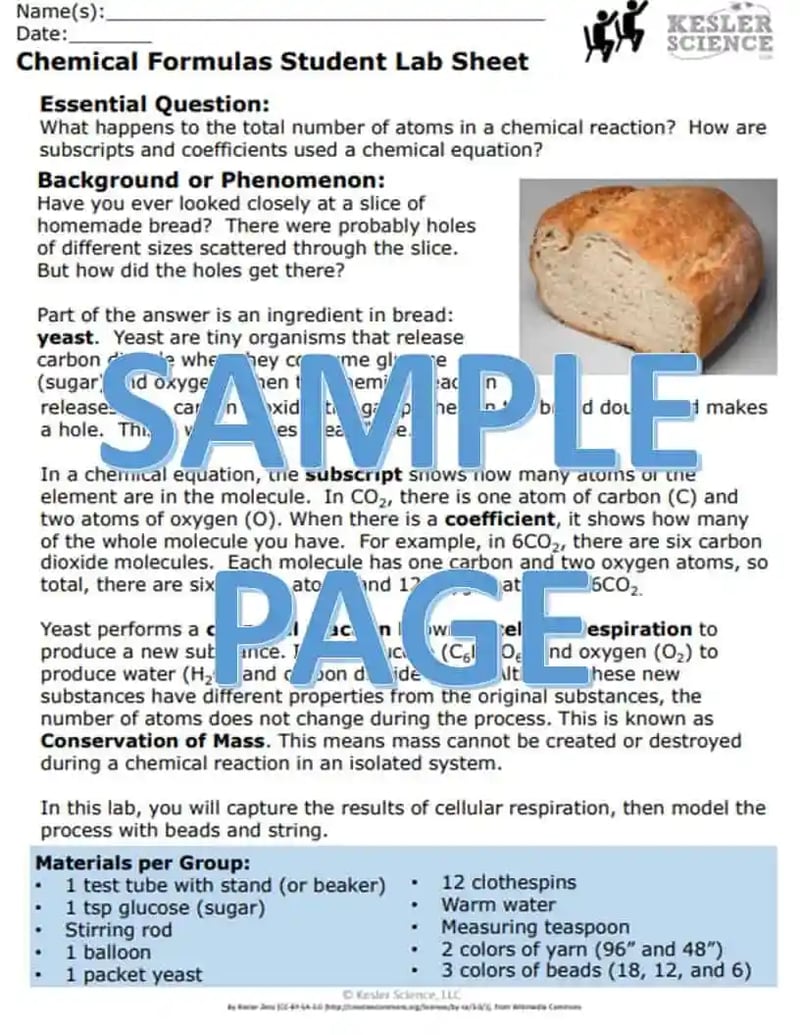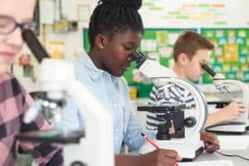Middle School Inquiry Lab on Conservation of Mass
In this lab, students will observe cellular respiration and its chemical equation. Students will then create a model to demonstrate the conservation of mass within cellular respiration.
Each inquiry lab will contain an essential question that will drive the lesson and make students think. For this lesson, the essential questions are:
- What happens to the total number of atoms in a chemical reaction?
- How are subscripts and coefficients used in a chemical equation?

BACKGROUND INFORMATION AND MATERIALS LIST:
Students will begin the lab by reading the essential question and background information. This can be done individually, as lab groups, or as a whole class. Personally, I would do it in lab groups and then do some whole class formative checks before digging into the lab.
Materials List:
- 1 test tube with stand (or beaker)
- 1 tsp glucose (sugar)
- stirring rod
- 1 balloon
- 1 packet of yeast
- 12 clothespins
- warm water
- measuring teaspoon
- 2 colors of yarn (one color cut at 96" and the other color cut at 48")
- 3 colors of beads (18 of one, 12 of another, and 6 for the third)
PROCEDURE:
Students will be completing two activities for this lab. First, students will create a chemical reaction by mixing items together in a test tube. The chemical reaction will have evidence of a gas production which is why students will have to trap the gas using a balloon.
While the students are waiting for the reaction to be completed, they will then create models of glucose and of oxygen. The models are to help students visual conceptualize how the law of conservation of mass shows that the beginning mass (reactants) will equal the ending mass (products).
CHECK FOR UNDERSTANDING:
At this point in the lab, students will be checked for understanding by answering questions about their findings. Here are a few that come with the lab:
- What do you notice is happening to the balloon?
- Why do you think this is happening?
CONCLUSION
Students will go back to the essential question and write a CER (Claim, Evidence, Reasoning) to conclude the lab. Once completed, students will reflect back on their learning by answering the following questions.
- What does a coefficient tell you about molecules?
- What does a subscript tell you about the atoms in a molecule?
- The following equation is the reaction that produces glucose: photosynthesis. How many of each atom do you start with?
MODIFIED AND INDEPENDENT INQUIRY VERSIONS
All of the Kesler Science inquiry labs come with three different modification levels. Each lab is differentiated using the icons below.
.webp?width=805&height=410&name=Screen-Shot-2018-12-03-at-9.48.46-AM%20(2).webp)
STANDARDS ALIGNMENT
TEKS: 8.5D – Recognize that chemical formulas are used to identify substances and determine the number of atoms of each element in chemical formulas, containing subscripts.
NGSS: MS PS1 - 5 – Develop and use a model to describe how the total number of atoms does not change in a chemical reaction and thus mass is conserved.
.webp?width=800&height=120&name=Escape-Room-Banners-2%20(1).webp)
Download Over $100 in FREE Resources
For Middle School Science
Simply create a login below and gain immediate access to a selection of our Kesler Science product line worth $100 - for FREE. There's a full version of every product type! You'll also join tens of thousands of middle school science teachers who receive timely tips and strategies straight to their inbox.





